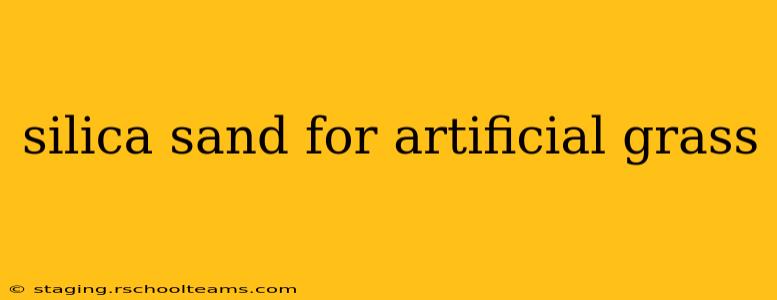Artificial grass, a popular choice for landscaping and sports fields, relies heavily on the quality of its infill material. Silica sand, a common choice, plays a crucial role in determining the performance, longevity, and overall look of your artificial turf. This comprehensive guide will delve into the specifics of using silica sand for artificial grass, addressing common questions and concerns.
What is Silica Sand and Why is it Used in Artificial Grass?
Silica sand, primarily composed of silicon dioxide (SiO2), is a naturally occurring granular material known for its durability, hardness, and excellent drainage properties. In artificial grass, it serves several key functions:
-
Drainage: Silica sand facilitates water drainage, preventing waterlogging and ensuring the surface remains playable (or aesthetically pleasing) even after heavy rainfall. Poor drainage can lead to the growth of mold and mildew, negatively impacting the turf's lifespan and visual appeal.
-
Stability: The sand helps to stabilize the artificial grass blades, keeping them upright and preventing matting or compaction. This ensures a consistent playing surface and maintains the lush appearance of the turf over time.
-
Weight: Silica sand provides ballast, adding weight to the artificial grass system. This helps to anchor it in place, preventing it from being displaced by wind or heavy foot traffic.
-
Cost-effectiveness: Compared to other infill materials, silica sand is relatively inexpensive, making it a budget-friendly option for many artificial grass installations.
What are the Different Types of Silica Sand Used for Artificial Turf?
While the composition is largely the same, silica sand for artificial grass can vary slightly in grading and particle size. The optimal size is crucial for proper drainage and stability. Generally, a finer grade of sand is preferred for infill, as it fills the gaps between the turf fibers more effectively.
Is Silica Sand Safe for Children and Pets?
This is a frequently asked question, and the answer is generally yes, when sourced responsibly. High-quality silica sand is non-toxic and inert, posing no significant health risks to children or pets. However, it's crucial to ensure the sand is free from contaminants, such as heavy metals or other harmful substances. Look for silica sand specifically marketed for use in artificial grass installations, as these are usually rigorously tested for safety. Always check the supplier's certification and safety data sheets.
What are the potential downsides of using silica sand?
While silica sand offers numerous benefits, it's not without drawbacks. One major concern is dust. Fine silica sand can become airborne, potentially causing respiratory irritation. This is particularly relevant in areas with high winds or during installation. Additionally, some argue that silica sand doesn't provide the same level of shock absorption as other infill materials, such as rubber crumb.
How Much Silica Sand Do I Need for My Artificial Grass?
The amount of silica sand needed varies depending on the size of the area, the type of artificial grass, and the desired infill depth. Consult your artificial grass installer or the manufacturer's guidelines for specific recommendations. Typically, infill depth ranges from 10 to 15 mm.
How is Silica Sand Installed in Artificial Grass?
Silica sand is typically spread evenly over the artificial grass surface after installation. Special equipment can be used to ensure consistent and uniform distribution. After spreading, the sand should be brushed into the turf pile to ensure proper penetration.
What are the Alternatives to Silica Sand for Artificial Grass Infill?
While silica sand is a common choice, other infill materials exist, each with its own advantages and disadvantages. These include rubber crumb, recycled plastic, and other organic materials like coconut coir. The best option depends on budget, environmental concerns, and desired performance characteristics.
Is Silica Sand environmentally friendly?
The environmental impact of silica sand is a complex issue. While silica itself is a naturally occurring material, the extraction and transportation processes can have negative environmental consequences. The dust generated during installation and use is also a concern. Choosing a responsible supplier committed to sustainable practices is crucial.
This guide offers a comprehensive overview of using silica sand for artificial grass. Always remember to consult with professionals for advice tailored to your specific needs and location. Careful planning and selection of high-quality materials will ensure a long-lasting, safe, and aesthetically pleasing artificial grass installation.
